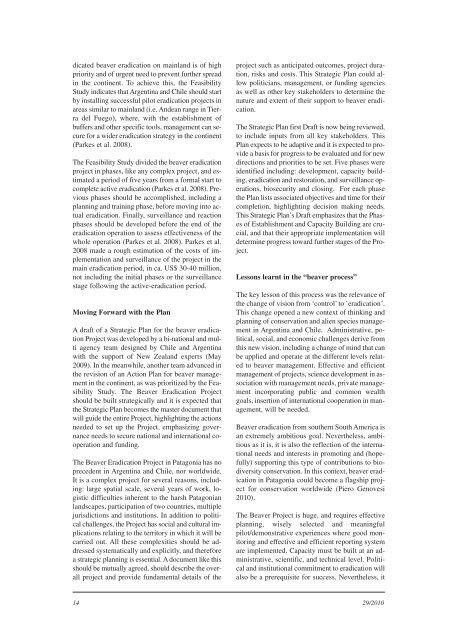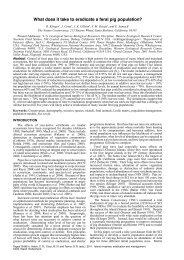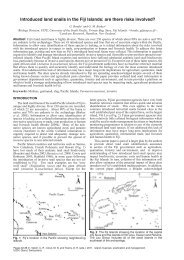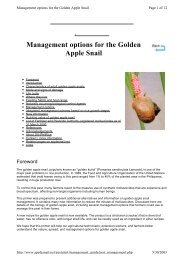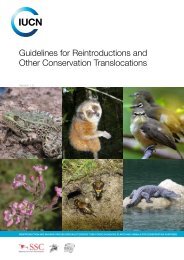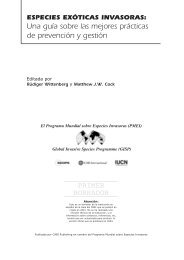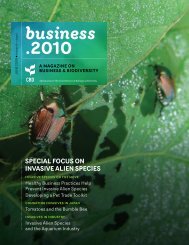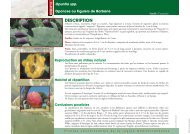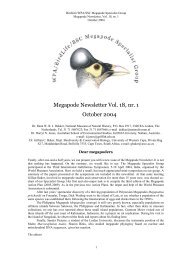Aliens Newsletter - ISSG
Aliens Newsletter - ISSG
Aliens Newsletter - ISSG
Create successful ePaper yourself
Turn your PDF publications into a flip-book with our unique Google optimized e-Paper software.
dicated beaver eradication on mainland is of high<br />
priority and of urgent need to prevent further spread<br />
in the continent. To achieve this, the Feasibility<br />
Study indicates that Argentina and Chile should start<br />
by installing successful pilot eradication projects in<br />
areas similar to mainland (i.e. Andean range in Tierra<br />
del Fuego), where, with the establishment of<br />
buffers and other specific tools, management can secure<br />
for a wider eradication strategy in the continent<br />
(Parkes et al. 2008).<br />
The Feasibility Study divided the beaver eradication<br />
project in phases, like any complex project, and estimated<br />
a period of five years from a formal start to<br />
complete active eradication (Parkes et al. 2008). Previous<br />
phases should be accomplished, including a<br />
planning and training phase, before moving into actual<br />
eradication. Finally, surveillance and reaction<br />
phases should be developed before the end of the<br />
eradication operation to assess effectiveness of the<br />
whole operation (Parkes et al. 2008). Parkes et al.<br />
2008 made a rough estimation of the costs of implementation<br />
and surveillance of the project in the<br />
main eradication period, in ca. US$ 30-40 million,<br />
not including the initial phases or the surveillance<br />
stage following the active-eradication period.<br />
Moving Forward with the Plan<br />
A draft of a Strategic Plan for the beaver eradication<br />
Project was developed by a bi-national and multi<br />
agency team designed by Chile and Argentina<br />
with the support of New Zealand experts (May<br />
2009). In the meanwhile, another team advanced in<br />
the revision of an Action Plan for beaver management<br />
in the continent, as was prioritized by the Feasibility<br />
Study. The Beaver Eradication Project<br />
should be built strategically and it is expected that<br />
the Strategic Plan becomes the master document that<br />
will guide the entire Project, highlighting the actions<br />
needed to set up the Project, emphasizing governance<br />
needs to secure national and international cooperation<br />
and funding.<br />
The Beaver Eradication Project in Patagonia has no<br />
precedent in Argentina and Chile, nor worldwide.<br />
It is a complex project for several reasons, including:<br />
large spatial scale, several years of work, logistic<br />
difficulties inherent to the harsh Patagonian<br />
landscapes, participation of two countries, multiple<br />
jurisdictions and institutions. In addition to political<br />
challenges, the Project has social and cultural implications<br />
relating to the territory in which it will be<br />
carried out. All these complexities should be addressed<br />
systematically and explicitly, and therefore<br />
a strategic planning is essential. A document like this<br />
should be mutually agreed, should describe the overall<br />
project and provide fundamental details of the<br />
project such as anticipated outcomes, project duration,<br />
risks and costs. This Strategic Plan could allow<br />
politicians, management, or funding agencies<br />
as well as other key stakeholders to determine the<br />
nature and extent of their support to beaver eradication.<br />
The Strategic Plan first Draft is now being reviewed,<br />
to include inputs from all key stakeholders. This<br />
Plan expects to be adaptive and it is expected to provide<br />
a basis for progress to be evaluated and for new<br />
directions and priorities to be set. Five phases were<br />
identified including: development, capacity building,<br />
eradication and restoration, and surveillance operations,<br />
biosecurity and closing. For each phase<br />
the Plan lists associated objectives and time for their<br />
completion, highlighting decision making needs.<br />
This Strategic Plan’s Draft emphasizes that the Phases<br />
of Establishment and Capacity Building are crucial,<br />
and that their appropriate implementation will<br />
determine progress toward further stages of the Project.<br />
Lessons learnt in the “beaver process”<br />
The key lesson of this process was the relevance of<br />
the change of vision from ‘control’ to `eradication´.<br />
This change opened a new context of thinking and<br />
planning of conservation and alien species management<br />
in Argentina and Chile. Administrative, political,<br />
social, and economic challenges derive from<br />
this new vision, including a change of mind that can<br />
be applied and operate at the different levels related<br />
to beaver management. Effective and efficient<br />
management of projects, science development in association<br />
with management needs, private management<br />
incorporating public and common wealth<br />
goals, insertion of international cooperation in management,<br />
will be needed.<br />
Beaver eradication from southern South America is<br />
an extremely ambitious goal. Nevertheless, ambitious<br />
as it is, it is also the reflection of the international<br />
needs and interests in promoting and (hopefully)<br />
supporting this type of contributions to biodiversity<br />
conservation. In this context, beaver eradication<br />
in Patagonia could become a flagship project<br />
for conservation worldwide (Piero Genovesi<br />
2010).<br />
The Beaver Project is huge, and requires effective<br />
planning, wisely selected and meaningful<br />
pilot/demonstrative experiences where good monitoring<br />
and effective and efficient reporting system<br />
are implemented. Capacity must be built at an administrative,<br />
scientific, and technical level. Political<br />
and institutional commitment to eradication will<br />
also be a prerequisite for success. Nevertheless, it<br />
14 29/2010


